During the last photo trip I hosted at Lofoten, I used the new Haida M10 filter system together with their new filters. Although I was somewhat skeptical at first, I found it to be a really nice system that worked very well under cold conditions. This is my review.
Ten years ago, I started with Lee filters and was content with it. Demands grew and finally I ended up with the amazing filters from Kase. I wrote an article on that transition here on Fstoppers, which you might like to check out also.

Shooting long exposures can be fun, and can provide a new dimension to your photos. For this you need to use filters and a filter system is a good choice. For Winter at Lofoten I was asked to use the new Haida M10 system with the new Red Diamond filters. (250mm | ISO100 | f/8 | 120s | Haida ND1000)
Somewhere between Lee and Kase I used filters from Haida for a while. These filters were okay, but not great. I had some issues with the way Haida constructed the filter holder. On top of that, I wasn’t that fond of the filters. Again, these were okay, and gave good results, but these did not live up to my expectations.
Last year I was contacted by Haida again to test their brand new M10 filter system, together with the new improved Red diamond filters. Although I invested seriously in the Kase system, I decided to give it a try. Haida kindly provided me with a beautiful set of filters for my trip "Winter at Lofoten, Norway."

I used the new Haida M10 system and Red Diamond filters during the Winter at Lofoten tour. Between snow and rain I was able to play a lot with these beautiful filters.
My First Impression of the Filter Holder
The new Haida M10 filter holder is nothing like the old one. Its design is completely new and improved, incorporating a drop-in slot for a polarization filter, or neutral density filters. Neutral density drop-in filters with built in polarization are also available. There are square filters slots too, allowing the normal 2mm thick 100 x 100cm and 100 x 150cm filters to be used.
The holder is connected to the lens through an adapter ring, just like any other system. A large spring-loaded red lever provides a good connection between holder and adapter ring. It is easy to rotate the filter holder when connected, and I found no dangers of losing the filter holder while working or walking with the camera; it stays perfectly in place.
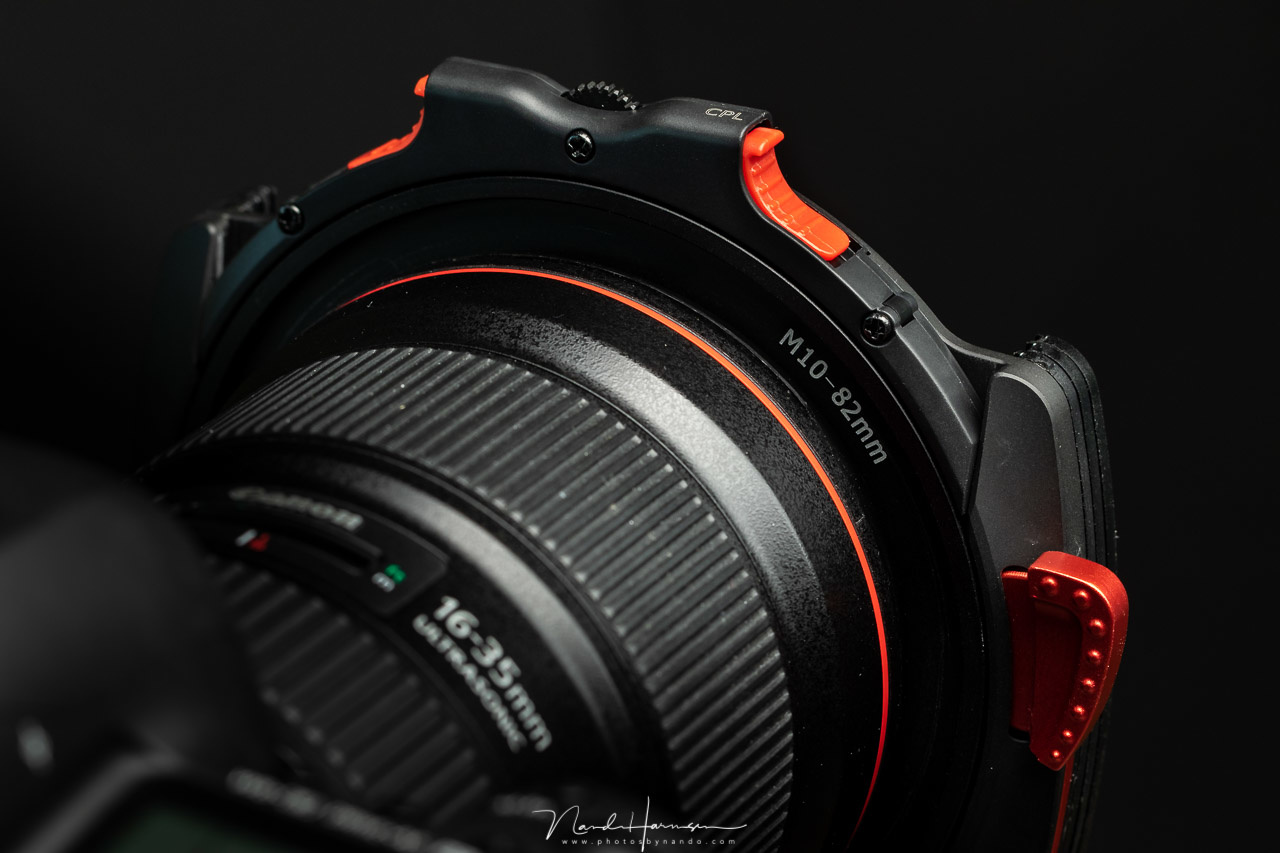
The filter holder is hold in place by a spring-loaded red lever. There is no risk of losing the filter holder with normal use. And by change it fits quite nicely with the red L-series lenses. I am sure it will also fit with the red accent of the Nikon cameras.
The polarization filter needs to be dropped into the drop-in slot. A small rotating wheel on top of the filter makes it possible to rotate the polarization filter without having to remove any other filters that might be placed. When no polarization filter is needed, a dummy drop-in ring can be inserted to prevent any light leaks.
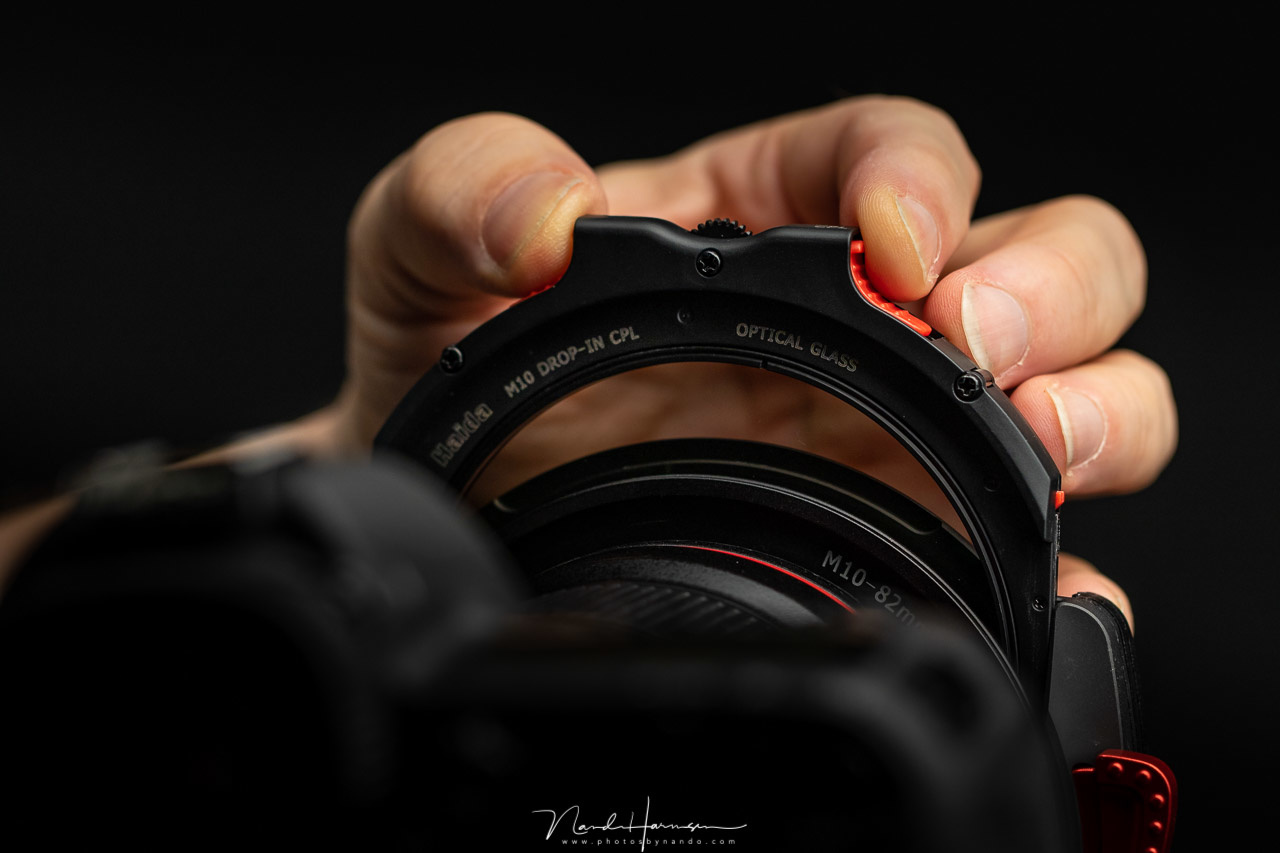
A polarizer can be placed in the drop-in slot. A small rotation dial makes it possible to rotate the filter to the right angle. The filter also accepts other drop-in filters provided by Haida.
The drop-in filters slide in easily, but you have to make sure they’re positioned in the right way. There is a front-side and back-side. Small plastic notches hold the drop-in filters in place.
The inside of the filter holder has a thin ring of foam, to prevent any light leaks when using dark neutral density filters. And indeed, the neutral density filters don’t have a foam ring themselves. Foam is provided with the filters nevertheless, making it possible to use the filters in other filter holders.
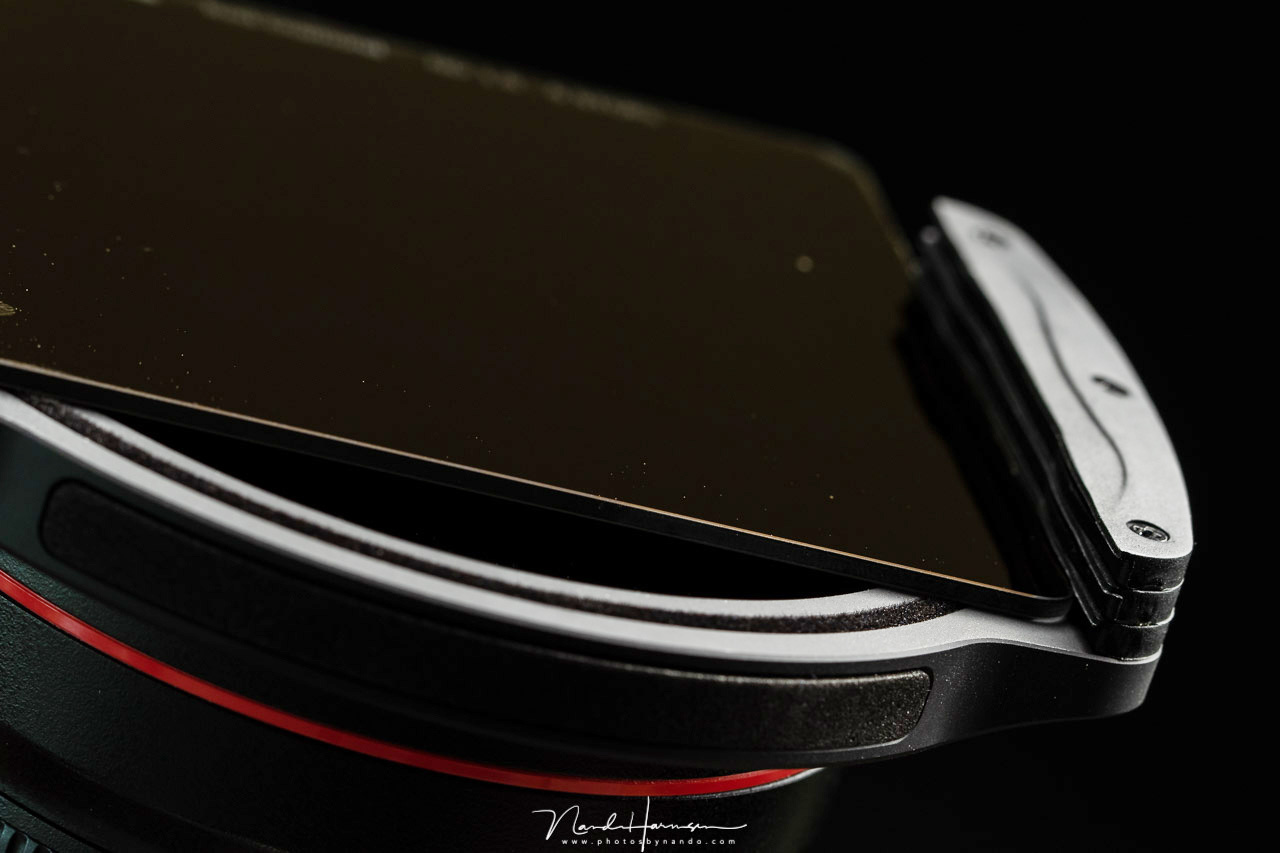
There is a thin foam ring on the inside of the filter holder. It prevents light leaks when using dark ND filters.
The filter holder itself comes with a rather large round pouch, giving room for the polarization filter and the dummy ring. It provides a good protection for the holder but it will take a lot of space in your bag. It can easily be connected to a D-ring outside the camera bag if you like.
I used an M10 filter bag that gave room for all the filters I needed, including the filter holder. You can wear it on your belt, or hang it on the tripod, allowing easy access to any filters you have in the filter bag. I can definitely recommend the M10 filter bag.
My First Impression of the Red Diamond Filters
Haida has a new line of filters, called the Red Diamond line. These filters have a quality look and feel to it, with rounded corners and a beautiful finish. Although these filters are made from hardened glass, being able to survive a fall, I did not try this at home. And not on Lofoten either as a matter of fact.

THe drop-in filters are kept in place by two small notches on the side. It is enough to prevent the drop-in filter from falling out. It works very well.
The round drop-in filters are also made from hardened glass, but fitted into a plastic ring that slides in the filter drop-in slot. Two notches hold the filter in place, and it stays in place regardless of the position of the filter holder. The filters are easy to remove, but you have to check the position of the filter before you place it in the holder. It only fits one way.
The square filters come in a metal hinged box, providing a maximum safety. The round filters are placed in a translucent plastic box. As said, I left all boxes at home, carrying the filters in the M10 filter bag.
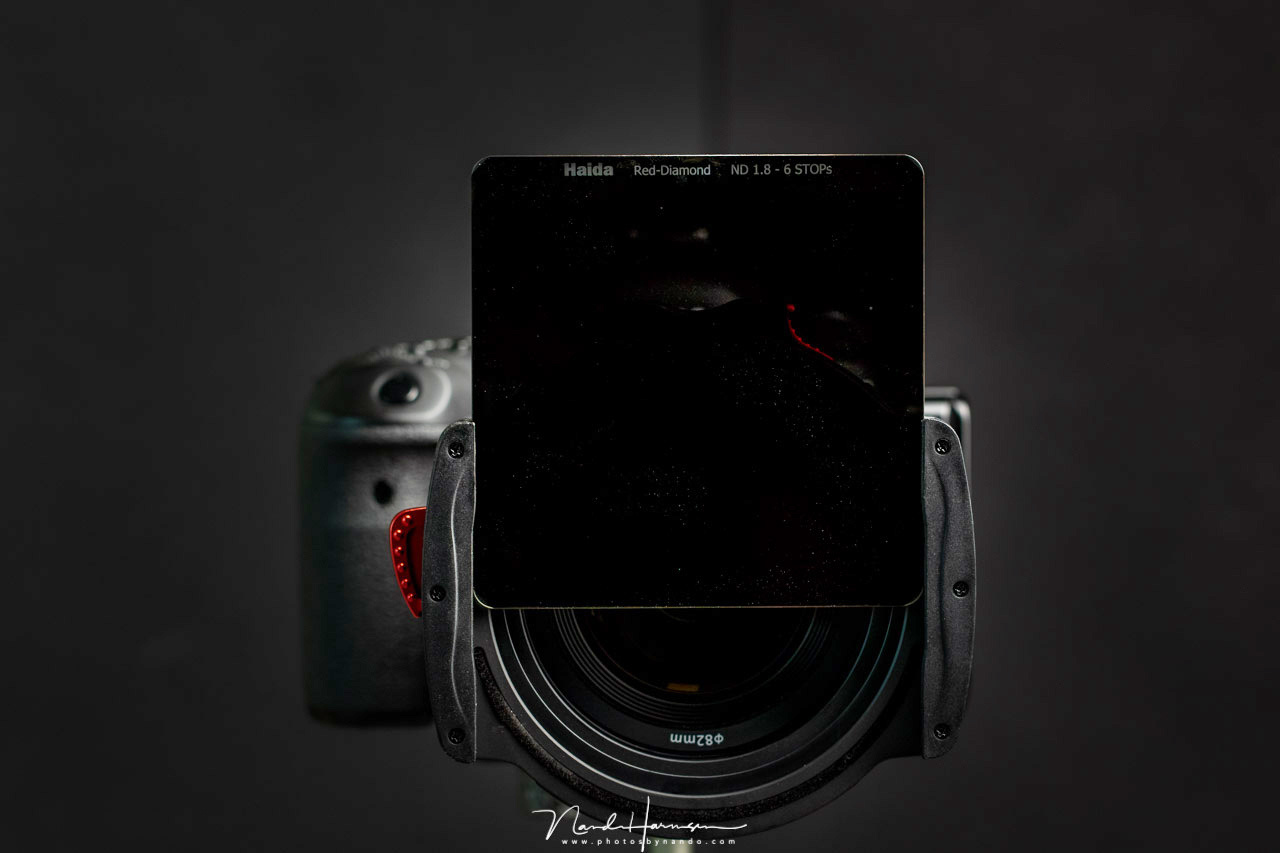
The ND64, six stops filter in the M10 filter holder.The filters have a real high quality. But the text can be hard to read under certain angles.
It can be difficult to see which filter you take from the bag. The square filters have a thin outline text which can be difficult to read at times. The drop-in filters have a notification on top, but it is in a gray text on a dark underground, making it really hard to read. It doesn’t matter that much when you only use a polarization filter, but when you have multiple drop-in filters, it is easy to grab the wrong one.

With normal light the text on the drop-in filters can be read quite easily. But the light is not always good, making it hard to distinguise the filters if you have more than one.
Using the Filter System During the Harsh Weather Situation at Lofoten
I got a chance to use the filters during my annual "Winter at Lofoten" trip. This year we had a Polar Low, with strong winds and fierce snow showers. At times it was difficult or even impossible to use filters, but we had some really nice moments for long exposure photography.
I kept the adapter rings on my lenses at all times, with special lens caps that fit the adapter ring. It prevents a constant placing or removing rings on the lenses. When I wanted to place the M10 filter holder, I found out it can be placed very easy with just one hand. It is really a matter of seconds.

Shooting on a beach at Lofoten with the tides coming in. Working with the Haida filterholder is really easy, which allows you to keep an eye on the waves. (63mm | ISO400 | f/22 | 1/9s | Haida 0,9GND medium CPL)
I had a few drop-in filters with me, like the polarization filter and a combination of the polarization filter with the ND64. I also had a normal square ND64 filter, a ND1000 filter, and a three-stop medium GND filter with me.
Placing filters was just as easy, or as difficult as any other filter system. Except the drop-in filters, which fell into place when dropping these filters into the slot. The square filters took a little bit more effort, especially the dark neutral density filters, that had to be placed against the foam ring inside the filter holder. With a bit of effort, I could place and remove filters with my gloves on.

When working in cold environments, you might want to use gloves. The M10 system is easy to use with gloves, but you might have some difficulties when rotating the polarization filter.
How Do the Filters Perform?
With every new type of filters, the ND1000 seems to be the reference. How does the color hold up when using a “big stopper?” Does it shift colors, or not? As expected from a high-end filter like the Haida Red Diamond series, there is no color shift visible whatsoever. I wouldn't be surprised if these ND1000 filters are one of the best available.

Using long exposures on a beach at Lofoten. You have to be patience with it and wait for the exposure to finish while the wave come crushing in. (63mm | ISO100 | f/11 | 60s | Haida ND1000 CPL 0,9GND medium)
Of course, this is not a scientific laboratory test, but I didn’t see any difference in color in real life use. Also stacking filters won’t change the color. At one time I stacked a ND1000 and ND64 for an eight minute exposure without any problems.

Doing real long exposures with stacking filters. In this case I used a drop-in ND64/CPL and the ND1000. Don't forget to turn of long exposure noise reduction. (250mm | ISO100 | f/10 | 480s | Haida ND64/CPL ND1000)

A behind the scene shot, Shooting with the Fujifilm GFX100 and Haida filters turned out to be lots of fun.
Difficulties I Encountered
There were some things I did run into when using these filters. I already mentioned the notifications on the filters, making it hard identifying them in the field. Especially the drop-in filters can’t be read that easy. But perhaps the weather conditions weren’t making it easy also. Time will tell.
Another thing I ran into was the rotation dial of the polarization filter. It is quite small, and rotating the dial is rather difficult because of that. Especially with gloves. But when you are using the large 100 x 150mm filters, which stick out on top of the filter holder, it may obstruct an easy use of the dial.
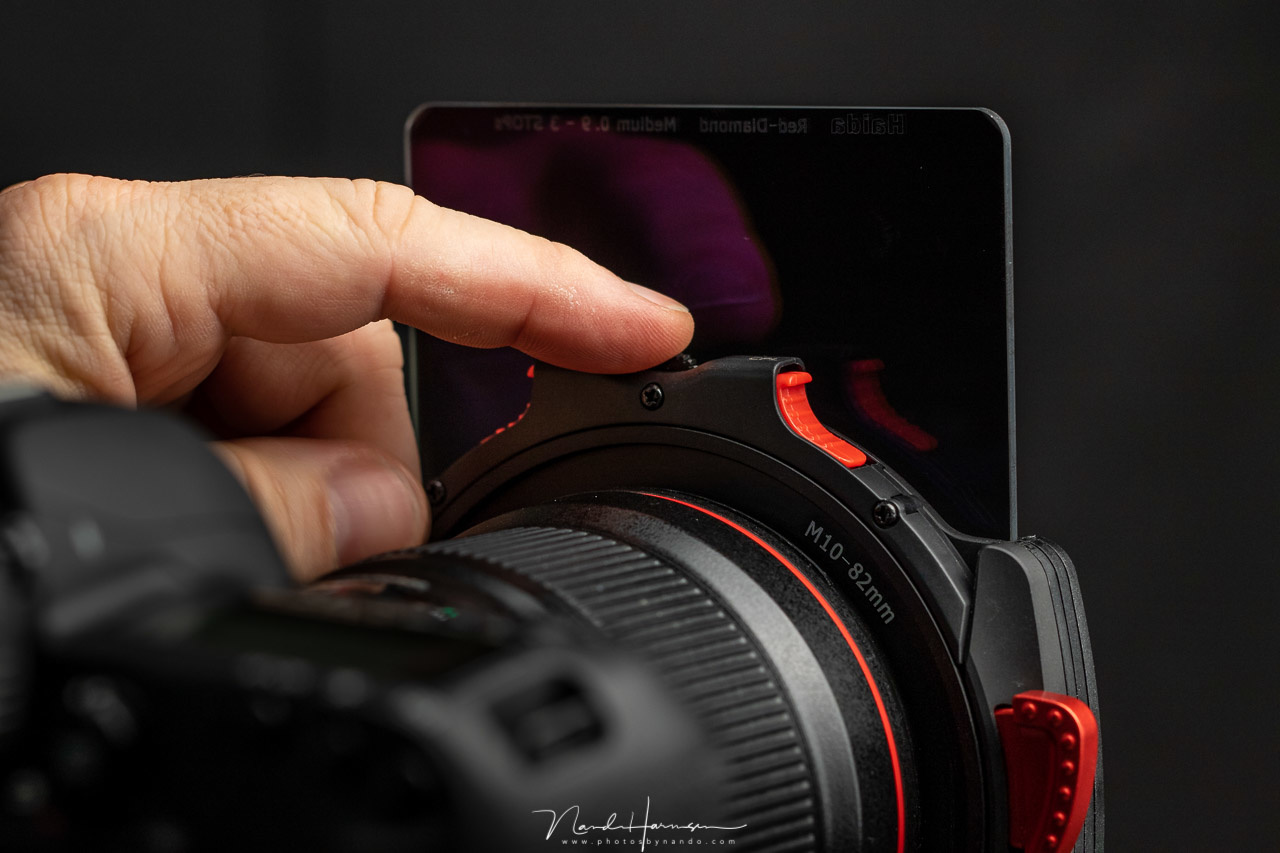
I found out the difficulty of rotating the filter when a large gradient filter is in place. It it possible, but when wearing gloves like at Lofoten, it becomes almost impossible. This could be improved.
Although the filter holder can be placed within seconds, there is no locking mechanism. It means the holder can easily rotate by accident. It is not a very big deal, because there is absolutely no danger it will fall off, but you have to keep an eye on the position.
What Could Be Improved
If I could improve the M10 filter holder, it would be a locking knob to prevent the M10 filter holder from rotating.
I also would like the dial for the polarization filter to be larger for easy use. If there is a way of replacing that dial to the side of the holder, it would be a real improvement.
Lastly, I would advise Haida to make the notification on the filters more clearly, so they’re easier to read. Especially on the slot-in filters a larger contrast between the text and background would be a big improvement.
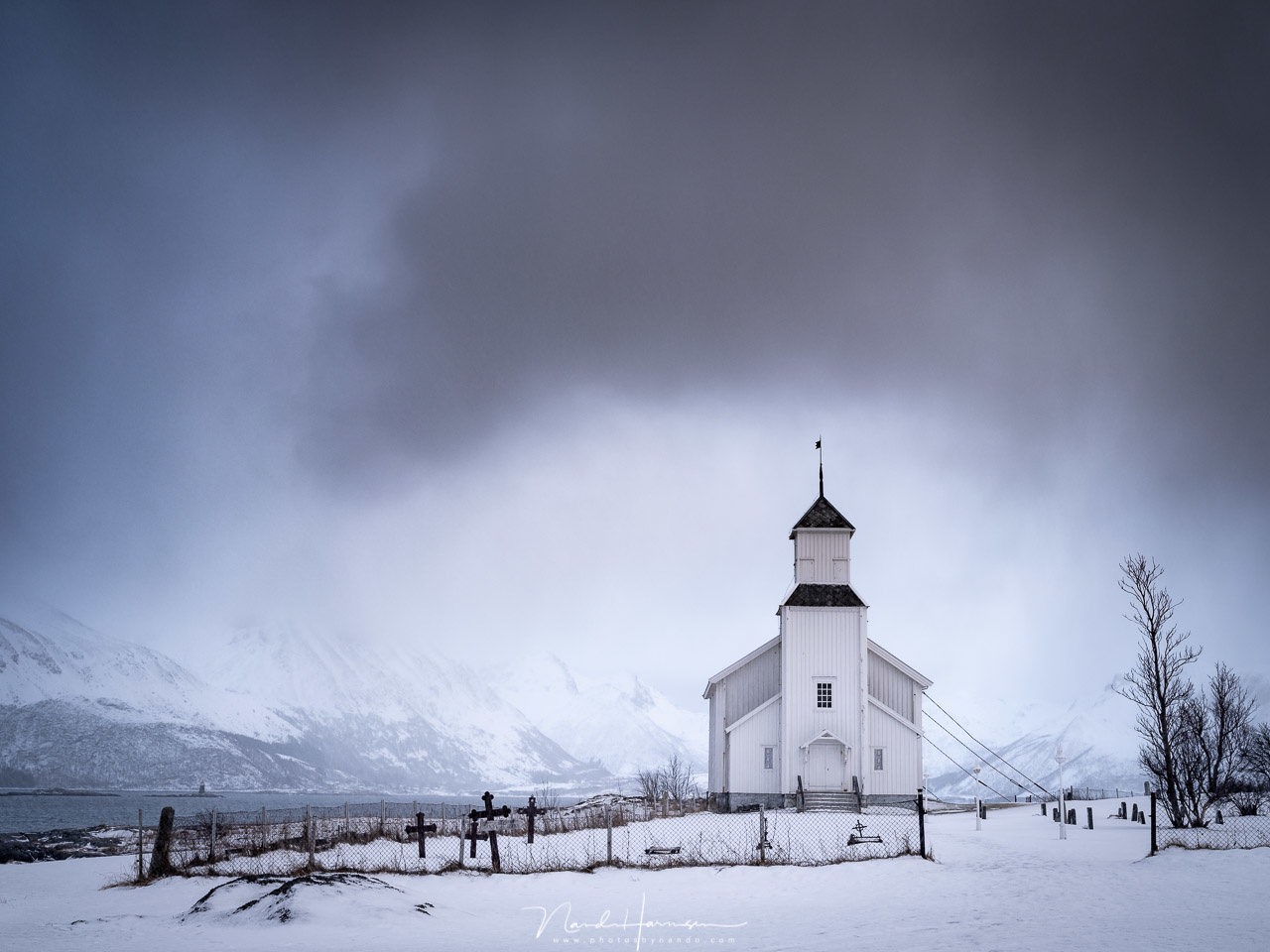
Capturing the small church at Gimsøy beach with the use of a gradient filter. You could do this in post-production also, but it is much more fun when it can be accomplished at the location itself. That is why I love using filters (63mm | ISO320 | f/8 | 1/50s | haida 0,9GND medium)
My Opinion About the M10 Filter Holder and Red Diamond Filters
Before I write down my opinion about this filter system, it must be said Haida provided the filters and asked me to write a review for it, which I have done. But I have reviewed the filters with an open mind, being honest at all times. If I didn’t like the filters, I would have said so.
I was surprised to see the difference with the old Haida filters from a couple of years ago. But also the M10 holder is absolutely much better. The new M10 system is very well designed and works very well. Even with gloves on it is easy to connect the holder to the lens, or change filters. I loved using it.
The system is not perfect though, but from what I have seen on the market, no filter system is. I believe Haida has come very close to a perfect system. Except for the few things that could be improved, of which some are very easy to accomplish.
I think combining the regular filter holder with the drop-in system is a good choice. It makes the system very flexible and it has become very easy to stack multiple filters. When using ND drop-in filters the risk of light leaks is almost eliminated completely. And Haida provides drop-in ND filters with polarization also, which is clever.
What I Like
- The filter holder is very well constructed
- The Filter holder is very easy to place
- The filter holder is very light
- Drop-in filters work really well
- With the drop-in ND filters light leaks are eliminated
- Drop-in ND filters are also available in combination with polarization capabilities
- Filters have a very good quality feel
- The filters should be strong enough to survive a fall (but I did not test that)
- No visible color shifts with the heavy ND filters
- Filters come in nice hinged metal containers
What I Didn’t Like
- No locking mechanism to prevent holder from rotating
- The rotation dial on the drop-in polarization filter is very small
- Difficult to read the type of filter on the drop-in filters
- The plastic rind around the drop-in filters feels a bit cheap

The small village of Nusfjord at Lofoten during twilight. (23mm | ISO100 | f/11 | 8s | Haida 0,9GND medium)
Would I advise photographers to buy this filter system? Yes, I would without doubt. Although it is not perfect, and subject for improvement, it is a very user friendly filter system. It works very well and is very flexible in real life use. I like the quick way it connects to the adapter ring. Although the slot-in filters seemed to be a hassle at first, I really started to like using these filters.
If I had to make a choice, I would use the slot-in for the ND filters primarily, and the normal slots for the gradient filters.
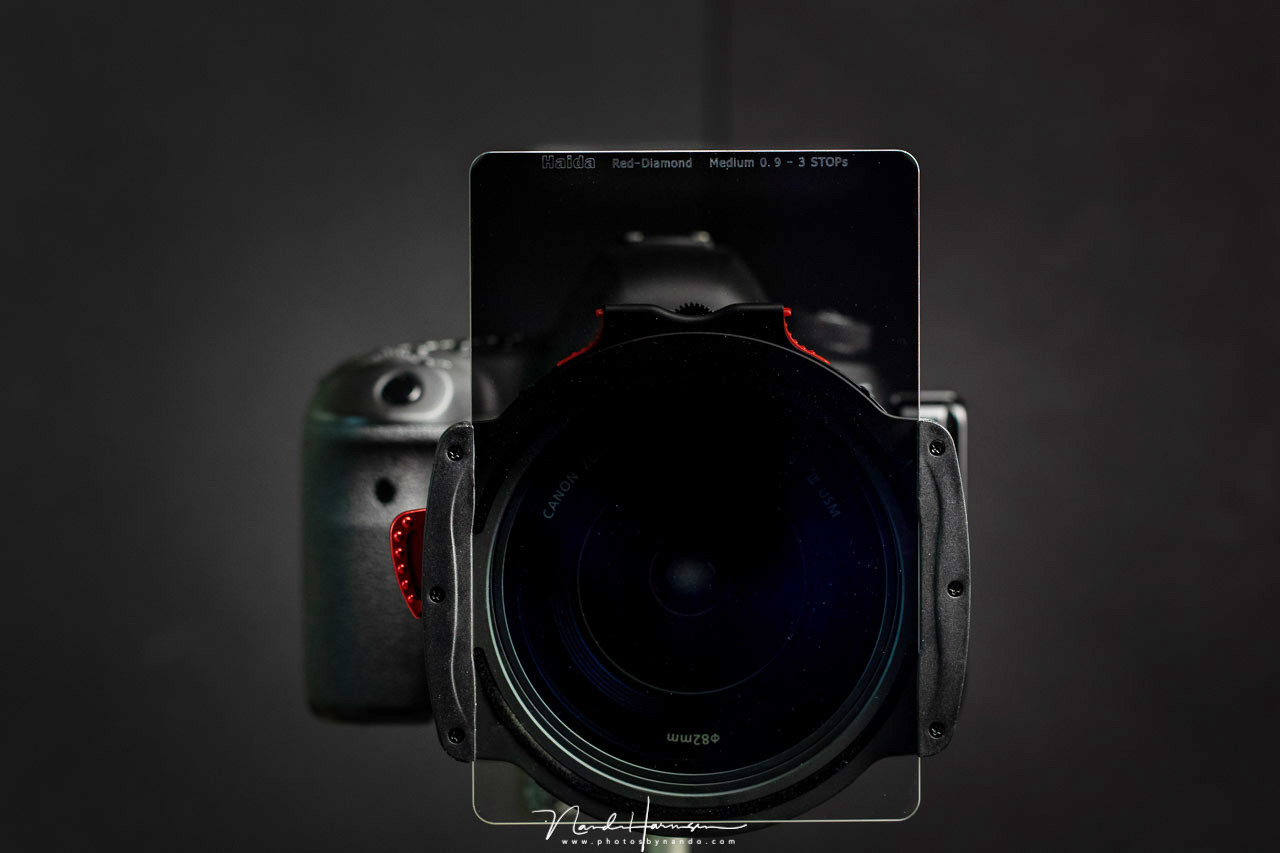
I enjoyed using the Haida M10 filter holder, and the Red Diamond filters. I think it is a very good product and I will keep on using it.
Which filter system do you use for your landscape photography? Do you like your filter system and how do you think it would compare with this new Haida M10 system and Red Diamond filters? I love to read your opinion in the comments below.








Too bad it doesn’t incorporate a small matte box design with the ability to add a French flag. Would like one system not multiple pieces in the camera bag.
That is why there are are nice bags for filters
Hi Nando, I've read with great interest both your reviews for Haida and Kase. If you were to recommend only one system, in terms of filter quality and practicality in the field, which would it be? Thank you!
Both are really good. Regarding usability, the Haida works better. But the Kase is a bit smaller in size.
I would recomment Haida at this time
Thank you! Also, the Haida M10 filter kit appear much cheaper than the Kase in the Netherlands. Looking to replace my Lee filters, I think I'll break the bank with Haida!
Are you buying in the Netherlands?
If so, may I advise a place to buy?
Yes, in the Netherlands. I was thinking ordering directly on the Haida Store. But if you have another suggestion, I'm all ears :)
Yes. http;//www.omnifoto.nl
You found it already. Good.
I love this filter system and would highly recommend it.
Hi Nando, some questions, can one use the cpl without the holder in place like the nisi and kase traditional rear mount cpls? Sometimes for weight saving purposes I don't always want to carry the holder? Lastly, I have read on social media that H&Y filters have a copyright lawsuite against Haida for infringing on H&Y's design on drop in CPL, are you aware whether this is true or not? I wouldn't want to consider investing in a holder that is potentially in breach of another manufacturer's copyright?
Thanks for your questions.
It is one of the downsides of the Haida system; you cannot use the CPL without the holder, like the Kase system.
I don't know anything about the lawsuits you mention. I think a lot of manufacturer's are trying to earn easy money by lawsuits and copyright claims against other companies.
If you don't want to invest in those manufacturer's, you probably don't want to buy an iPhone of Samsung smartphone either. These companies are fighting each other all the time.
Quote Caption: Doing real long exposures with stacking filters. In this case I used a drop-in ND64/CPL and the ND1000. Don't forget to turn of long exposure noise reduction. (250mm | ISO100 | f/10 | 480s | Haida ND64/CPL + ND1000)
Dont forget to turn off or turn on? why?
Turn off, of course. With a 480 seconds exposure, with LNR it will take twice that long
Thank you. Will take note of this
I like the system very much. However, I think the polarizer is weak. The filter doesn’t come close to eliminating all the glare off of water. The effect should be stronger.
I never had any problems with the polarizer. But eliminating glare depends on the angle. And don't forget, if you use extreme wide angle, the effect is not equal over the frame